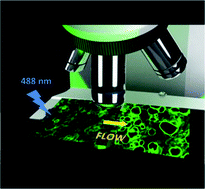Direct observation of athermal photofluidisation in azo-polymer films†
Abstract
The surface relief gratings (SRGs) can be generated when azo-polymer films are exposed to laser beam interference as a result of mass migration. Despite considerable research effort over the past two decades this complex phenomenon remains incompletely understood. Here we show, for the first time, the athermal photofluidisation of azo-polysiloxane films exposed to 488 nm light, directly monitored by optical microscopy. A process of surface relief erasure occurring in parallel with its inscription was also observed during laser irradiation. We therefore propose a new mechanism of SRG formation, based on three different processes: (1) the polymer photo-fluidization in illuminated regions, (2) the mass displacement from illuminated to dark regions and (3) the inverse mass displacement, from dark to illuminated regions. The mechanical properties of the films during UV light irradiation were investigated by classical rheology and, for the first time, by using amplitude modulation-frequency modulation atomic force microscopy (AM-FM AFM).


 Please wait while we load your content...
Please wait while we load your content...